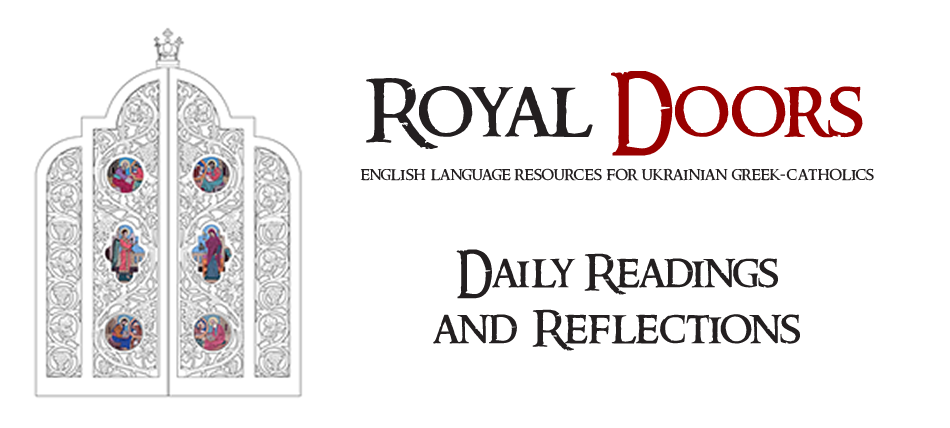by Brent Kostyniuk
“Then we went on to Greece, and the Greeks led us to the edifices where they worship their God, and we knew not whether we were in heaven or on earth. For on earth there is no such splendour or such beauty, and we are at a loss how to describe it.”
This is how Prince Vladimir’s emissaries described their experience of Byzantine Christianity in 987, leading to the baptism of Kiev in 988.
No doubt, the emissaries’ feelings were shaped by the richness of the Byzantine Tradition – they heard the beautiful singing, they smelled the burning incense rising upwards in offering, and above all, they had seen the walls and sanctuary covered in icons, windows to heaven.
Icons, from the Greek word eikōn, meaning image or likeness, are more theological lessons, rather than simply visual depictions of Christ and the saints. For this reason, icons are said to be written, rather than painted.
While a statue (or painting) represents a person or event in a realistic manner, it cannot portray the underlying spiritual reality. In an icon, we see and understand Christ as truly both God and man. Similarly, we see the saints not as they lived their lives on earth, but as they are now in heaven with their glorified bodies, interceding for those who pray to them. Although God the Father cannot be depicted (and never is) in an icon, (‘…no man has seen God” — John 1:18), as Christ took human form, He can be shown in icons.
The question of whether or not it is permissible to even consider portraying God through art was passionately debated in the early Eastern church and eventually led to two iconoclastic movements, first between about 726 and 787, and again between 814 and 842. Such was the vigour of the Byzantine iconoclasts, that they actively destroyed any image they found. From this comes our modern usage of the term, meaning someone who attacks cherished beliefs or principles. Iconoclasts saw any form of religious art as an offense against the Old Covenant prohibition against worshipping “craven images” (Exodus 20:4, Deuteronomy 5:8).
Happily, the iconoclasm heresy was overcome thanks to the work of such defenders as St. John of Damascus.
If you understand that the incorporeal One became man for you, then it would be evident that you can make his human image. Since the Invisible One became visible by taking on flesh, you can fashion the image of Him whom you saw. Since He who has neither body nor form nor quantity nor quality, who goes beyond all grandeur by the excellence of His nature, He, being of divine nature, took on the condition of a slave and reduced Himself to quantity and quality by clothing Himself in human features. Therefore, paint on wood and present for contemplation Him who desired to become visible.
He is not worshipping the symbol, but merely venerating it. Such veneration is not directed toward wood, or paint or stone, but towards the person depicted.

From a religious perspective, a statue (or realistic painting) and an icon are very different things. A statue is meant to be the realistic depiction of a moment in earthly time. Take for example the Nativity scene, or creche, which appears in many Christian homes at Christmas. We see figures of the Baby Jesus, Mary, Joseph, along with magi, shepherds, and animals who came to adore Him. We get a glimpse of what it might have looked like 2000 years ago.
On the other hand, the Nativity Icon presents the Birth of Christ, along with the theology of the event. We see the joy of all creation as God became man and entered into our human life as a baby wrapped in swaddling clothes lying in a manger. His presence shines radically with the black opening of the cave in which He was born. Symbolically, the spiritual light of Christ’s birth radiates through the shadow of death encompassing man. The Virgin Mother is shown half-sitting, supported by a hammock-type bed used by the early Jews in their travels. Striking is the absence of the usual sufferings of childbirth, an indication of the virgin birth of Christ.
All creation is called to the birth. In the icon, we see an angel announcing the event to two shepherds. As well, three angels attend the birth, while a donkey and ox look on.
In the icon, several episodes are grouped together and shown simultaneously. In the bottom left corner, Joseph sits in painful thought, while the devil, under the guise of an old and bent shepherd, suggests new doubts and suspicions to him.
In the bottom right corner, two women are seen bathing the new-born infant, to show the true humanity of Jesus. The mountain side is a backdrop to the event. While it bears little correspondence to the terrain of Bethlehem, it parallels a line from the prayer of the Prophet Habakkuk, “God comes from Teman, the Holy One from Mount Paran. Covered are the heavens with His Glory, and with His praise the earth is filled” (Habakkuk 3:3). One final detail is the tree across from the image of Joseph, included not only in its own right as an offering to Christ, but also as the symbol of the Tree of Jesse. In the words of the Prophet Isaiah, “But a shoot shall sprout from the stump of Jesse, and from his roots a bud shall blossom. The spirit of the Lord shall rest upon Him” (Isaiah 11:1-2).
Icons truly are windows to heaven. Gazing not only at them but through them, we get a glimpse of the eternal reality of God, wondrous in His saints.
